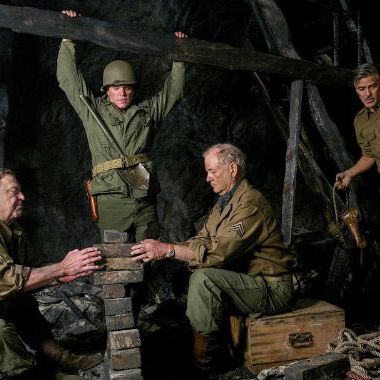
George Clooney’s The Monuments Men tells the true (if embellished) story of a squad of art experts tasked to protect masterpieces of European society from Nazi theft and Allied bombardment at the end of World War II — a story that might be expected (in this country, anyway) to elicit responses like, “Okay, but it seems weird to worry about paintings when millions of people are dying.” Clooney — who directed, co-wrote, and stars in the film — clearly anticipates such Yankee anti-elitism. He opens with a scene in which his character, Frank Stokes, makes the case to FDR (we view the back of the president’s head) that such works are the very foundation of the civilization that the United States seeks to protect. As the Allies drop bombs on cities in Germany, Italy, and France, he asks, “Who will make sure that the statue of David is still standing and the Mona Lisa still smiling?” Later, he labors to make the same case to commanding officers on the front lines, men obviously racked by the loss of Allied lives and incredulous (and indignant) at his request to stop shelling their art-filled targets. In a pep talk to his own men, Stokes avers that if these countries’ achievements and history are destroyed, “it’s like they never existed.”
I emphasize Clooney and co-writer Grant Heslov’s speechifying on behalf of their heroes’ mission to suggest why The Monuments Men never quite shakes off its family-friendly squareness. It’s a graceful, engaging film—I enjoyed it. But it could have been called The Tasteful Dozen. After helping to shape such acid, anti-imperialist movies as Syriana and David O. Russell’s Three Kings, Clooney must have been eager to make a hopeful, positive war picture, with a lighthearted marching-drum-and-woodwind score by Alexander Desplat — and an implicit subtext that government funding of the arts is vital to our very existence. But he plays it so safe. Perhaps fearful of being called exploitative, he doesn’t bring out the tension between timeless masterpieces and the chaos and obscenity of war. He doesn’t even linger on the paintings and sculptures, which seem like fodder, MacGuffins. And he panders to the mainstream audience. It’s only when the Monuments Men come up against snipers and murderous commandants that Stokes announces they’ve earned the right to wear their uniforms. But if they need to take bullets to prove they’re soldiers, what are all those high-flown speeches about preserving civilization about?
The all-star ensemble is at half-mast, though it’s hard to resist them. How can you not be charmed by the assembling-the-team sequence in which Matt Damon is plucked from atop a ladder as he works on a church ceiling and Bill Murray from leading a tour of a skyscraper? Alcoholic Hugh Bonneville has a chance to come back from disgrace and redeem himself, heart-wrenchingly. John Goodman gets a laugh by shrugging off basic training and waddling through an obstacle course while bullets fly around him. Jean Dujardin is the happy Frenchie, Bob Balaban the serious specialist who trades low-wattage insults with Murray. The pair has a good scene in which they visit a man with ties to France’s art world and discover some extraordinarily well-done reproductions on the walls. A little too well-done. There were worse crimes in the forties than stealing paintings, but low thievery of high art earns its own circle of hell.
At the inner circle, of course, is Hitler, who made Aryan culture a centerpiece of his Reich and directed Nazi soldiers to make off with every well-regarded painting and sculpture they could get their mitts on, plundering not just museums but the homes of deported Jews. The scale of that plunder is laid out in the 2006 documentary The Rape of Europa and thrillingly evoked in John Frankenheimer’s The Train, featuring Paul Scofield as an art-obsessed Nazi and Burt Lancaster as the stationmaster bent on keeping France’s masterworks from reaching Germany. In The Monuments Men, it’s seen through the eyes of Cate Blanchett as a prim, bespectacled French curator who secretly plots against a piggy S.S. man preparing trainloads of art for the Führer’s proposed Über-museum. (Now and then, there are shots of a diminutive Hitler staring at a model of this monument to himself.) Earnest Damon has to prove to Blanchett that he’s not rounding up paintings to ship back to America, and when she’s satisfied that his aim is art for art’s sake, she lets down her hair and wants into his pants. Alas, he’s been staring too long at church frescoes.
I can’t predict if there will be a huge audience for The Monuments Men, but in its way it’s a great piece of escapism. As Iraq explodes (we broke it, we didn’t buy it) and Afghanistan metes out madness and death once again to hubristic occupiers, World War II grows even larger in our hearts. Clooney wants us to agree that liberating the Madonna of Ghent from godless Nazi murderers was maybe our last selfless act as a nation in the theater of war. It’s a pipe dream of decency in a world that has lost its moral compass.
This review ran in the Feb. 10 issue of New York magazine.


